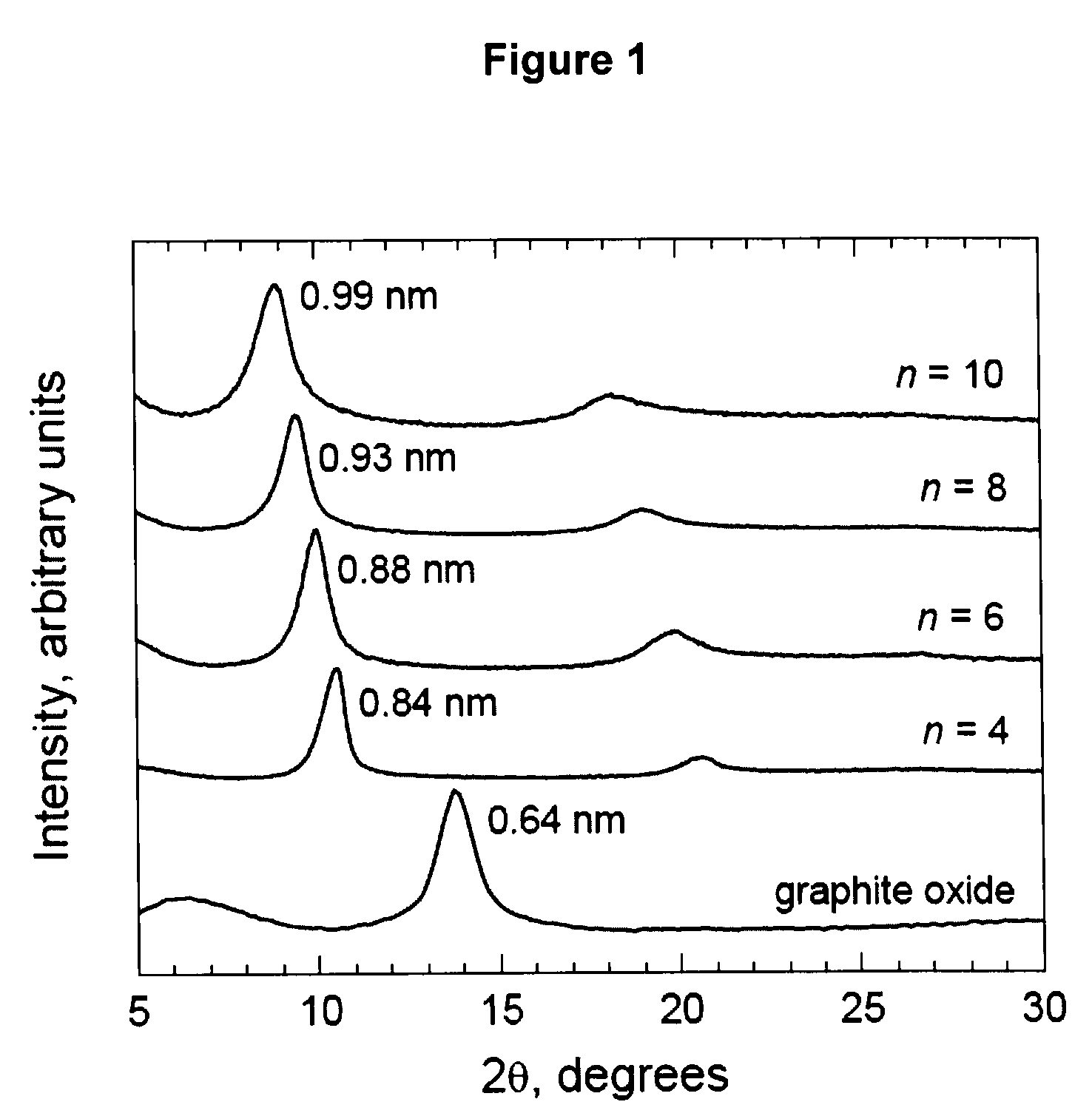Bridged graphite oxide materials
a graphite oxide and material technology, applied in the field of bridged graphite oxide compounds, can solve the problems of poor physical properties, tendency to collapse, and substantial expansion and delamination of intercalated graphite oxid
- Summary
- Abstract
- Description
- Claims
- Application Information
AI Technical Summary
Benefits of technology
Problems solved by technology
Method used
Image
Examples
example 1
[0028]Graphite oxide was intercalated with 1,4-diaminobutane; 1,6-diaminohexane; 1,8-diaminooctane; and 1,10-diaminodecane. X-ray diffraction patterns of the resulting intercalation compounds and GO oxide were obtained and are shown in FIG. 1., where “n” refers to the number of methylene units present in the diamine according to the formula H2N(CH2)nNH2. The interlayer spacing of the materials as calculated from the diffraction pattern are indicated next to the major peak for each sample and are given in Table 1.
[0029]
TABLE 1InterlayerIntercalantspacing (nm)None0.641,4-diaminobutane0.841,6-diaminohexane0.881,8-diaminooctane0.931,10-diaminodecane0.99
example 2
[0030]Graphite oxide was intercalated with 1,4-diaminobutane and n-butylamine. The resulting intercalation compounds were further treated with n-dodecylamine following the same procedure. X-ray diffraction patterns of the intercalation compounds were obtained before and after treatment with n-dodecylamine. In the case of the 1,4-diaminobutane, no significant change in the interlayer spacing was observed. In the case of n-butylamine, however, the interlayer spacing increased from about 0.85 nm to about 1.4 nm, indicating that cross-linking in the first case prevented the swelling that occurred in the second case. The X-ray diffraction patterns are shown in FIG. 2, where traces (a) and (b) correspond to the intercalation compound of 1,4-diaminobutane before and after treatment with n-dodecylamine, respectively, and where traces (c) and (d) correspond to the intercalation compound of n-butylamine before and after treatment with n-dodecylamine, respectively.
example 3
[0031]Graphite oxide was intercalated with 1,8-diaminooctane following the procedure given above, except that samples were refluxed for 1.5, 6, 24, and 120 hours. FIG. 3 shows the X-ray diffraction pattern for the four resulting intercalation compounds. The broad peak observed at 2θ=ca. 20.5-23° corresponds to an average interlayer spacing of about 0.4 nm, and is believed to be from disordered graphitic platelets, demonstrating that chemical reduction of graphite oxide has taken place.
PUM
| Property | Measurement | Unit |
|---|---|---|
| particle size | aaaaa | aaaaa |
| temperature | aaaaa | aaaaa |
| temperature | aaaaa | aaaaa |
Abstract
Description
Claims
Application Information
 Login to View More
Login to View More - R&D
- Intellectual Property
- Life Sciences
- Materials
- Tech Scout
- Unparalleled Data Quality
- Higher Quality Content
- 60% Fewer Hallucinations
Browse by: Latest US Patents, China's latest patents, Technical Efficacy Thesaurus, Application Domain, Technology Topic, Popular Technical Reports.
© 2025 PatSnap. All rights reserved.Legal|Privacy policy|Modern Slavery Act Transparency Statement|Sitemap|About US| Contact US: help@patsnap.com



